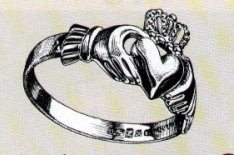There are many modern versions of the Claddagh Ring.
Here are some folk legends about the Claddagh:
It symbolizes LOVE (heart),
FRIENDSHIP & FAITH(hands),
and LOYALTY & FIDELITY(crown).
There was a Dublin version of this ring that appeared
some 100 years back with two hands and two Hearts
but no Crown. Some call this version the Fenian Claddagh.
The Crown to The Father, The Left hand to the Son,
and the Right Hand the the Holy Ghost.
This explanation is directly correlated to the Shamrock,
one of the earliest symbols of the Holy Trinity among the Irish.
Some will say that the crown represents Beathauile.
The left hand represents Anu who was the ancestral
and universal mother of the Celts and who later
changed her name Danu. The right hand represents
Dagda Mor, the father of the gods who was so
powerful he had the power to make the sun stand still.
The heart represents the Hearts of all mankind and that which gives the
everlasting music to the Gael.
Way back in the sandy mists of time, so the
story went, there was a great king who was madly
in love with a peasant woman--but as she was of a
lower class his love had to go unrequited. In suicidal
the king killed himself and had his hands lopped off
and placed around his heart as a symbol of his undying
love for the woman.
Another version o the Joyce tale tells that a
Margaret Joyce married Domingo de Rona,
a wealthy Spanish merchant who traded with Galway.
They proceeded to Spain, where he died, leaving her
a considerable fortune. Returning to Galway she used
her fortune to build bridges from Galway to Sligo,
and married one Oliver Og French, Major of Galway 1596-7.
She was rewarded for her good works and charity by an
eagle who dropped the original Claddagh ring into her lap.
By tradition the ring is taken to signify
the wish that Love and friendship should reign supreme.
The hands signify friendship, the crown loyalty,
and the heart love. The ring has become popular outside
Connamera since the middle of the last century -
its spread being helped by the vast exodus from
the West during the great Famine in 1847-49.
These rings were kept as heirlooms with great
pride and passed from mother to daughter.
Today, the ring is worn extensively across Ireland,
either on the right hand with the heart turned outwards
showing that the wearer is "fancy free" or with the
heart turned inwards to denote that he or she is
"spoken for". The pride of place is on the left hand,
with the heart turned in, indicating that the wearer is
happily married and the love and friendship
will last forever, the two never separated.
|
